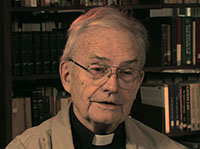Who Came and Who Stayed

Frank and Alex Hutmacher
The promise of 160 acres for little or no cost drew a wide range of people to the prairie, but once there, making a living for five years to “prove up” a claim was no easy task. Of the approximately two million claims made under the Homestead Act, only 40 percent were successful.
To succeed at homesteading, a family needed to know how to establish a self-sustaining farm, be willing to work long hours doing manual labor, and be able to endure difficult conditions.
Proving up a claim meant dealing with the harsh realities of life on a homestead. Homesteaders from families who had lived in the US for several generations knew that the country offered better opportunities elsewhere. If they did stayed and proved up the land, they could then sell it and move on.
After coming to North Dakota, sociologist Father William Sherman, now a retired priest and university professor emeritus, became curious about who settled North Dakota. He conducted extensive studies, finding that Norwegian, Swedish, German, German-Russian and Ukrainians were the ethnic groups who found the greatest success as homesteaders in the Dakotas. They were encouraged to emigrate to the US and settle the prairie by fraternal organizations, the railroads, and letters sent back home by earlier settlers.
In his studies, Father Sherman documented that immigrants did not homestead in isolation. A friend or family member would be first, and others would come and homestead in the surrounding area. In his book, “Prairie Mosaic” Father Sherman mapped out this pattern of ethnic settlements in North Dakota.
The German-Russians, however, were possibly the most suited to the demands of homesteading the prairies. They were Germans, who 100 years earlier, had been offered free land by the Russian government to settle areas in Ukraine, where the landscape is similar to North Dakota. The Germans from Russia brought with them both hardy winter wheat suited to the climate and building techniques that allowed them to construct sturdy structures from available materials.
They also brought a family history of being able to move to a new country and prosper, knowing that after their initial hardships, future generations would have a better life.
Father William Sherman

Father Sherman talks about his interest in the people who came to settle in North Dakota and how German-Russians and Ukrainians were well suited to homesteading the prairies.
Who Came and Who Stayed

